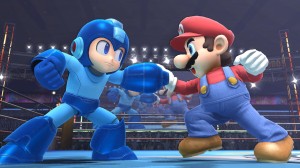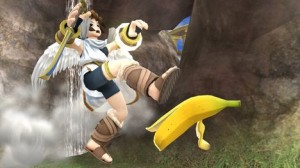Tomorrow Smash 4 3DS (as I have taken to writing it) hits US and European shelves and I plan on acquiring a copy partly out of my rampant fanaticism for the series and partly out of a desire to measure this iteration up against past console versions. The demo, which I previewed, gave a good taste for how the control scheme was adapted for the 3DS and helped to assuage some worries while confirming others. As of this writing, I intend to get a review up at Lcom as soon as I am able, and I plan on composing the review from the perspective of a person who enjoys Smash competitively more than casually. For a perspective on the game from the opposite angle I invite readers to look to almost any other popular gaming site, as their views have already been published a week ahead of launch.
It was when considering this approach that I wondered if some of the terms I am like to bring up in my review would be fully understood or appreciated by every reader at this site. I could expand on each subject in the review, but in the interest of not composing an arduously long review post I figured I would explain some of the more popular Smash technical terms and concepts this week coupled with some of my predictions about it in the next entry in the series. This article still assumes readers know the basics about how the game works. Without further ado:
Directional Influence
Commonly shortened to DI, this mechanic governs the player’s trajectory after they have flown a long distance from a hit. By pressing a perpendicular direction to the way one is flying it is possible to move slightly and increase survivability at long distances. For instance, a player is sent far to the right, that player would hold up on the control stick to gain height and make recovery easier. Similarly there is a mechanic named Smash DI, which is the ability of the player to control their trajectory during the hitstun animation, not after, of being hit by pressing a direction on the control stick.
There is currently some discussion over how this mechanic works in Smash 4 3DS and the jury seems to be out on how it will impact the game down the line. My experience during the very limited demo did not allow me any time for experimenting, but I will try to weigh in on it for my full release review.
Wavedashing
Probably the most common term to spring up in discussion about competitive Smash, and yet not entirely the most critical. It is a technique exclusive to Melee thanks largely to its use of directional limited air dodging. In Melee, air dodging could only be performed once between landing on the ground, and afterward would result in a “helpless” state where no further action can be performed. The action can be performed with the control stick to move a little in a given direction and Wavedashing is the act of air dodging into the ground while pressing left or right to gain a small distance of ground laglessly and faster than simply dashing in that direction. Ordinarily it is performed directly after a short hop, performed by quickly tapping the jump button to jump as short as possible, then immediately pressing a shoulder button and down-right or down-left on the control stick. The timing is strict, but the button combo is surprisingly easy to replicate with some practice.
Its exclusion from preceding Smash games is thanks to the new air dodging mechanic that allows repeated directionless dodges. Being an unintended consequence of Melee‘s physics engine, it was very likely made inoperable simply because Nintendo and Hal Labs went with the entirely different Havok engine for Brawl as opposed to a conscious decision. Overall I found the mechanic necessary mostly for characters I played very little with (Marth, Fox) and even then only at skill levels way above my own. At most levels of competitive play, it was rarely a deciding factor in a match.
L-Canceling
Also known as Lag or Land Canceling, is a built in game mechanic that allows players to cut the landing lag on aerial moves roughly in half. When a character performs an aerial attack and they touch the ground before the attack animation is completed, as is often the case with a short hopped aerial attack, then ordinarily that character suffers from some landing lag where the character gets to their feet. Pressing the L button (or Z button for Smash 64) at the right time would make that landing lag or animation go by much faster.
This game mechanic, officially coined “landing with style” in Smash 64, was purposely removed in Brawl for no other reason than to simplify the game. It is a mechanic separate from Teching (also known as Breakfall), which is still present in all games, wherein pressing one of the shoulder buttons when coming into contact with the ground during hitstun instantly gets the character to their feet instead of laying in a prone position. Thankfully at least this much has been preserved.

New third party fighters like Mega Man are continuing a recent tradition of non-Nintendo characters in Smash.
Hitstun
Speaking of hitstun, this mechanic has had a huge determining factor on how previous games have shaped up in the long term. It is the stunned state a character enters after being hit with a powerful attack wherein they can only control their trajectory and attempt break out of the state slightly early by wiggling the control stick.
Earlier games like Smash 64 and Melee had comparatively large amounts of hitstun, meaning the stunned state lasted longer, which opened attacked opponents up for follow up attacks or combos. Since the mechanic can determine how much another player is punished for their mistakes, Nintendo and Sakurai likely decided to tone down the amount of hitstun frames in Brawl so that attacked characters can defend themselves more easily. Giving players greater defenses resulted, unsurprisingly, in a much more defensive game which in turn lead to slow campy tournament matches between two Meta Knights running down the eight minute timer. It is likely the single greatest reason Melee has survived its own predecessor in tournament scenes across the world, as competitive play for that game is unquestionably more active than Brawl‘s.
There are many more terms I could throw at you, kind reader, but this piece has already run on for too long. Give me a shout below if there was anything here you learned or found interesting and let me know if you think you might play Smash 4 Wii U (or 3DS) when it comes to stores in about a month. If the early 3DS impressions indicate anything, the Wii U version could well be an improvement over Brawl‘s neutral heavy camp fest.

